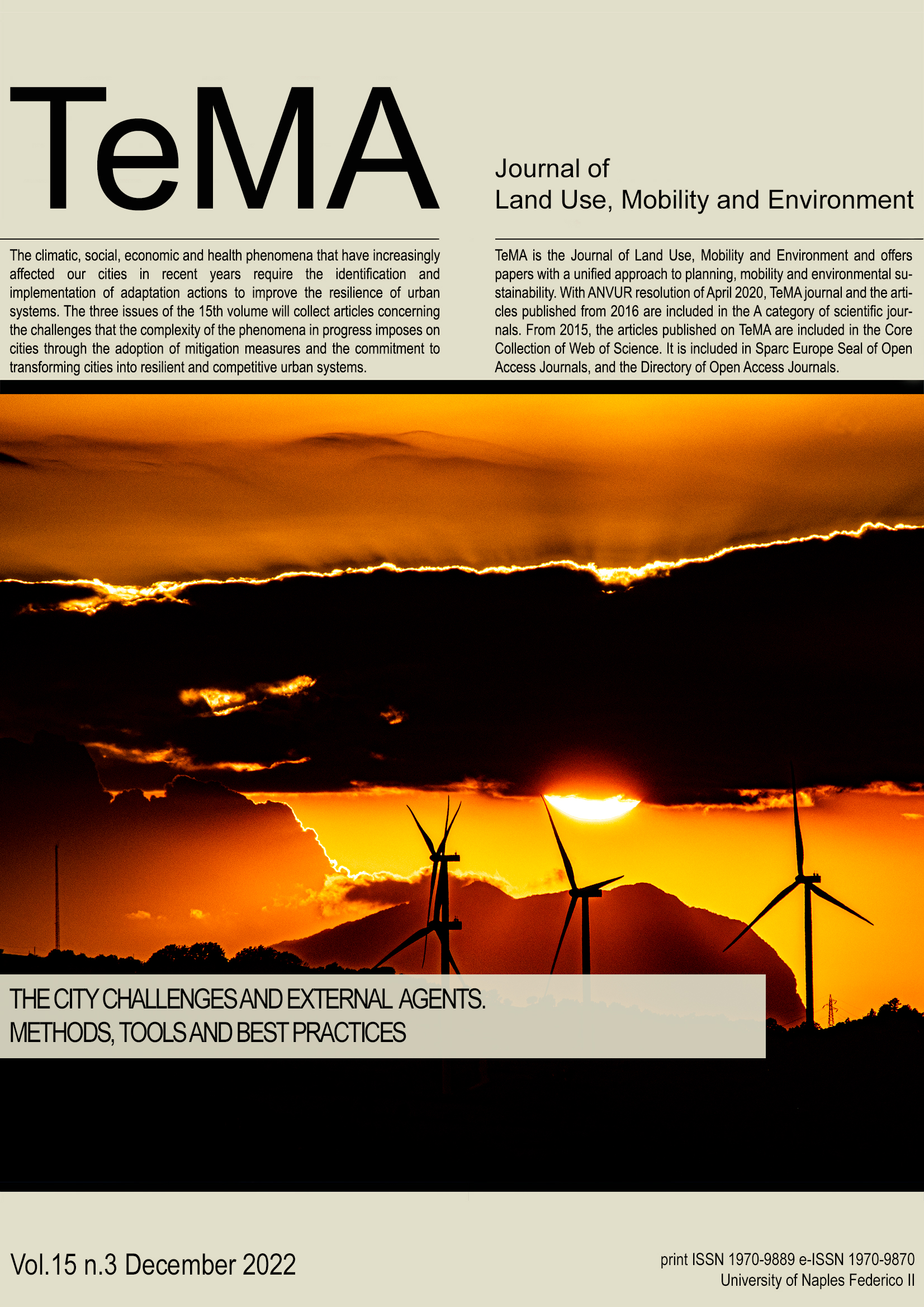Planning for sustainable urban mobility in Italy. Insights from Palermo and Cagliari
Abstract
Starting from the relationship between urban planning and mobility management, TeMA has gradually expanded the view of the covered topics, always following a rigorous scientific in-depth analysis. This section of the Journal, Review Notes, is the expression of a continuous updating of emerging topics concerning relationships among urban planning, mobility and environment, through a collection of short scientific papers. The Review Notes are made of four parts. Each section examines a specific aspect of the broader information storage within the main interests of TeMA Journal. In particular, the Urban Practices section aims at producing, analyzing and reporting data on recent and relevant policies in the urban domain.
The present note in particular reports on the recent initiatives undertaken by two major Southern Italian cities to foster sustainable mobility: Palermo and Cagliari. To this aim, the note briefly introduces the legal background and current developments of the Sustainable Urban Mobility Plan (SUMP), a framework developed by the European Commission to support local administrations in developing holistic urban mobility strategies. This is followed by (i) an overview of the mobility situations in Palermo and Cagliari and by (ii) an analysis of the objectives, the strategies and the measures set in their respective SUMPs.
Downloads
References
Chatziioannou, I., Alvarez-Icaza, L., Bakogiannis, E., Kyriakidis, C., & Chias-Becerril, L. (2020). A structural analysis for the categorization of the negative externalities of transport and the hierarchical organization of sustainable mobility’s strategies. Sustainability, 12(15), 6011. htps://doi.org/10.3390/su12156011
Eltis (2022). City Database. Retrieved from: https://www.eltis.org/mobility-plans/city-database. Last accessed: June 2022.
European Commission (2013a). Communication from the Commission to the European Parliament, the Council, the European Economic and Social Committee and the Committee of the Regions. Together towards competitive and resource-efficient urban mobility. Retrieved from: https://eur-lex.europa.eu/resource.html?uri=cellar:82155e82-67ca-11e3-a7e4-01aa75ed71a1.0011.02/DOC_3&format=PDF.Last accessed: June 2022.
European Commission (2013b). Commission staff working document accompanying the Communication Together towards competitive and resource-efficient urban Mobility. Retrieved from: https://eur-lex.europa.eu/legal-content/EN/TXT/PDF/?uri=CELEX:52013SC0526&from=NL. Last accessed: June 2022.
European Commission (2013c). Commission staff working document accompanying the Communication Together towards competitive and resource-efficient urban Mobility. Annex I: A concept for sustainable urban mobility plans. Retrieved from: https://eur-lex.europa.eu/. Last accessed: June 2022.
Gallo, M., & Marinelli, M. (2020). Sustainable mobility: A review of possible actions and policies. Sustainability, 12 (18), 7499. https://doi.org/10.3390/su12187499.
Gargiulo, C., & Russo, L. (2017). Cities and energy consumption: a critical review. TeMA-Journal of Land Use, Mobility and Environment, 10(3), 259-278. https://doi.org/10.6092/1970-9870/5182
Geels, F. W. (2012). A socio-technical analysis of low-carbon transitions: introducing the multi-level perspective into transport studies. Journal of transport geography, 24, 471-482. https://doi.org/10.1016/j.jtrangeo.2012.01.021.
Guida, C., & Caglioni, M. (2020). Urban accessibility: the paradox, the paradigms and the measures. A scientific review. TeMA-Journal of Land Use, Mobility and Environment, 13(2), 149-168. https://doi.org/10.6092/1970-9870/6743
Inrix (2021). Irix 2021 Global Traffic scorecard. Retrieved from: https://inrix.com/scorecard/. Last accessed: June 2022.
IPCC — Intergovernmental Panel on Climate Change (2014). Mitigation of climate change. Contribution of working group III to the fifth assessment report of the intergovernmental panel on climate change. Retrieved from: https://repository.uneca.org/handle/10855/22514. Last accessed: June 2022.
Lucas, K., & Jones, P. (2012). Social impacts and equity issues in transport: an introduction. Journal of Transport Geography, 21, 1-3. https://doi.org/10.1016/j.jtrangeo.2012.01.032.
Migliore, M., D’Orso, G., & Caminiti, D. (2020). The environmental benefits of carsharing: the case study of Palermo. Transportation Research Procedia, 48, 2127-2139. https://doi.org/10.1016/j.trpro.2020.08.271
Metropolitan City of Cagliari (2022). Piano Urbano della Mobilita Sostenibile. Retrieved from: https://www.cittametropolitanacagliari.it/portale/it/focus_pums_01.page Last accessed: October 2022.
Municipality of Cagliari (2022). Piano Urbano della Mobilita Sostenibile. Retrieved from: http://www.cittametropolitana.pa.it/provpa/provincia_di_palermo/amministrazione_trasparente/00020470_P.U.M.S.__Piano_Urbano_della_Mobilita_Sostenibile__della_Citta_Metropolitana_di_Palermo.html. Last accessed: October 2022.
Osservatorio PUMS (2022a). Palermo. Retrieved from: https://www.osservatoriopums.it/palermo. Last accessed: October 2022.
Osservatorio PUMS (2022a). Cagliari. Retrieved from: https://www.osservatoriopums.it/cagliari. Last accessed: October 2022.
Copyright (c) 2022 TeMA - Journal of Land Use, Mobility and Environment

This work is licensed under a Creative Commons Attribution 4.0 International License.
Authors who publish in this journal agree to the following:
1. Authors retain the rights to their work and give in to the journal the right of first publication of the work simultaneously licensed under a Creative Commons License - Attribution that allows others to share the work indicating the authorship and the initial publication in this journal.
2. Authors can adhere to other agreements of non-exclusive license for the distribution of the published version of the work (ex. To deposit it in an institutional repository or to publish it in a monography), provided to indicate that the document was first published in this journal.
3. Authors can distribute their work online (ex. In institutional repositories or in their website) prior to and during the submission process, as it can lead to productive exchanges and it can increase the quotations of the published work (See The Effect of Open Access)

